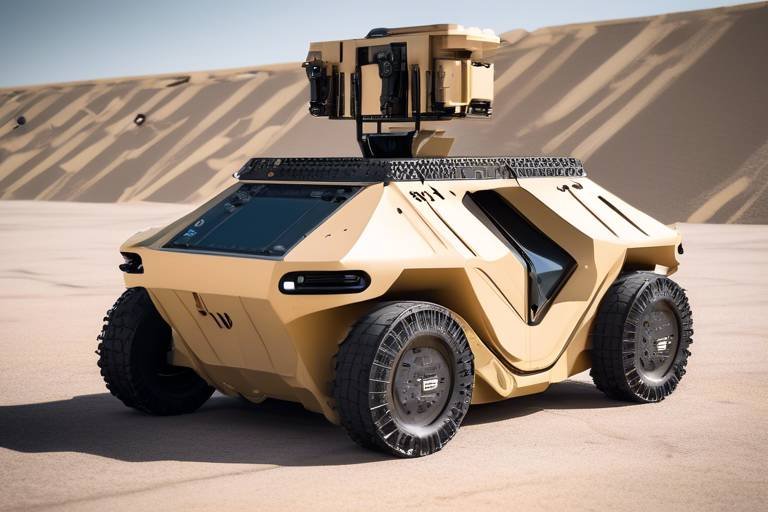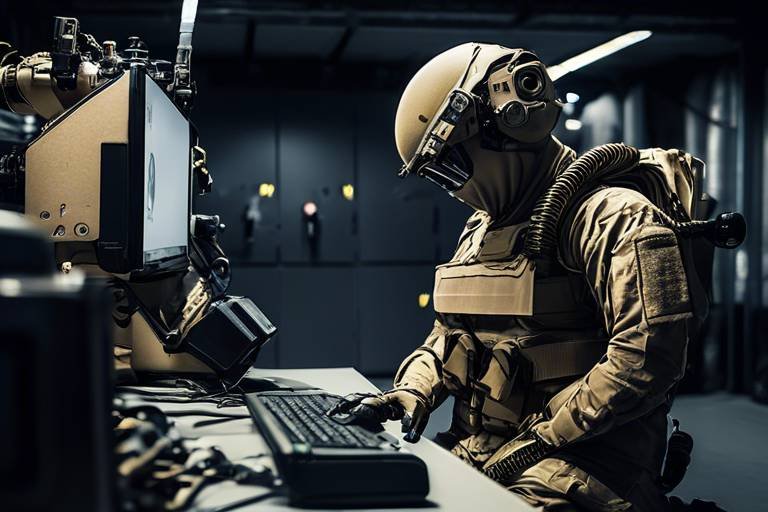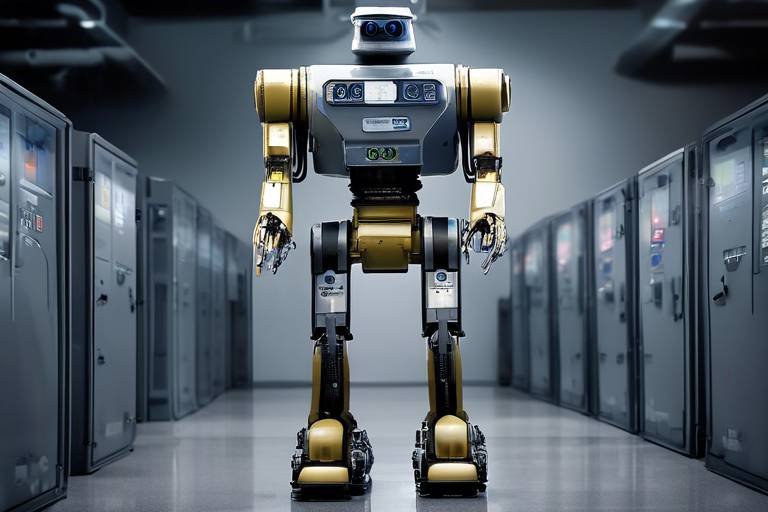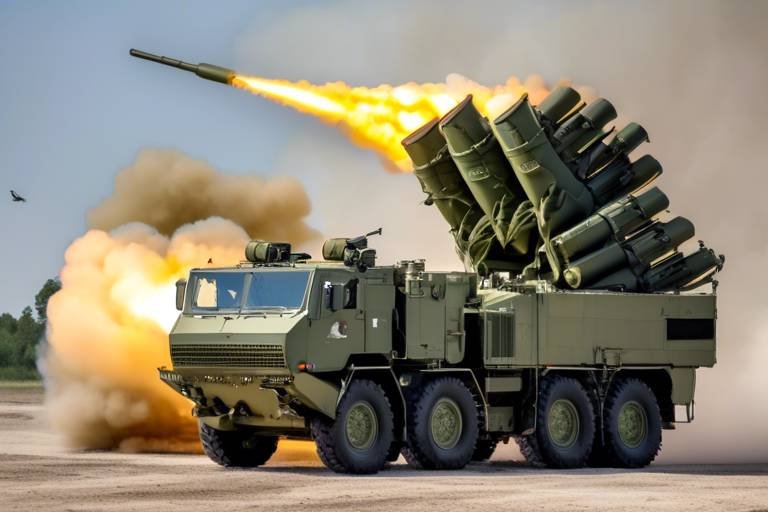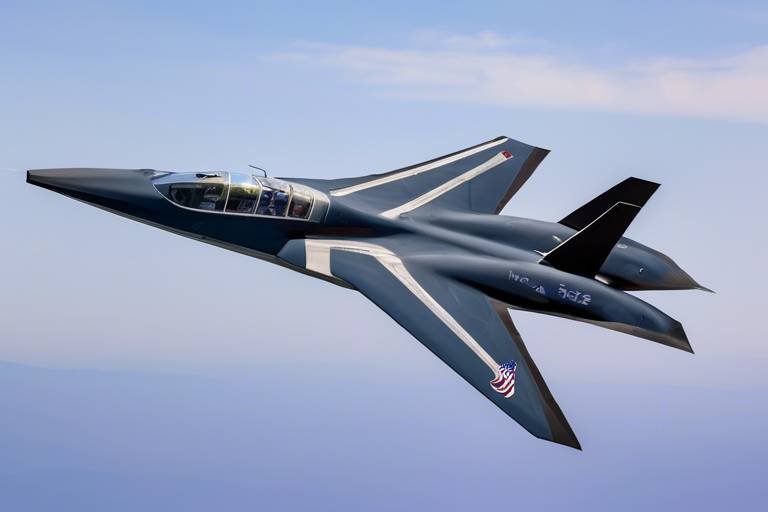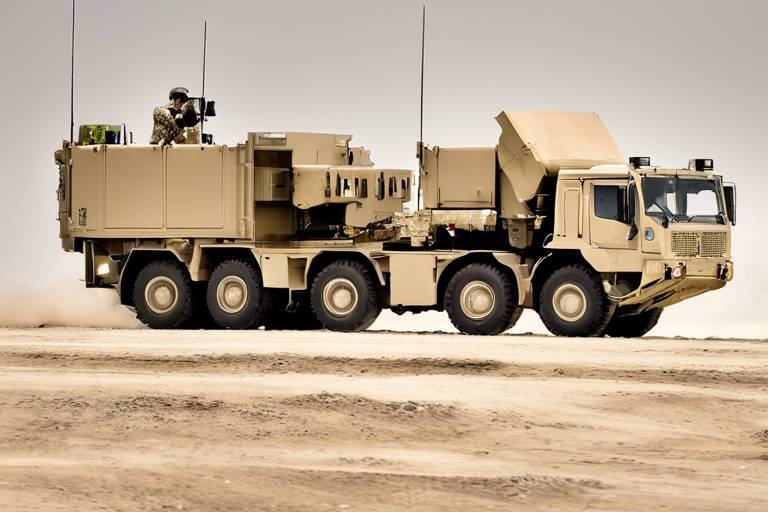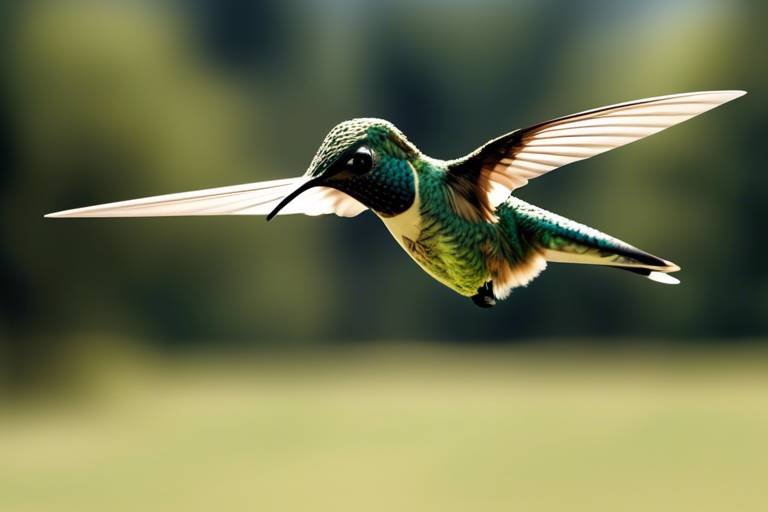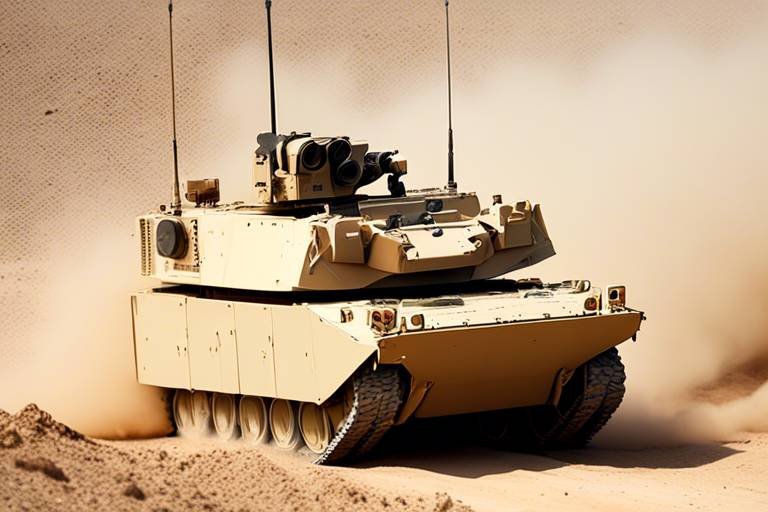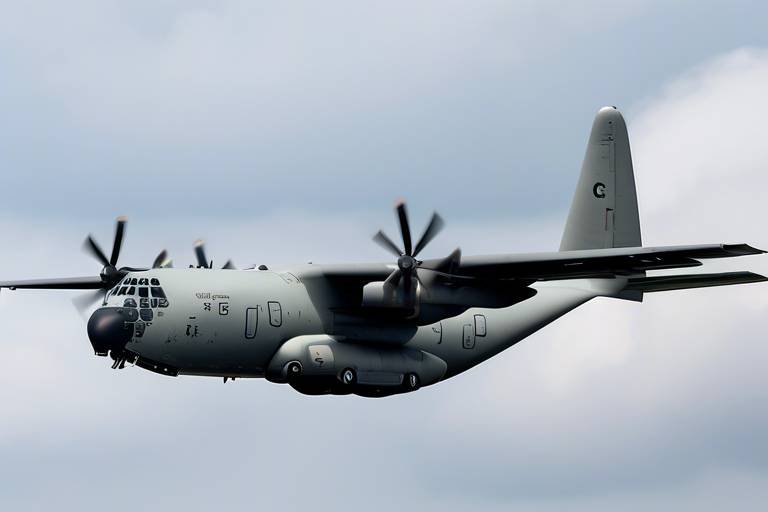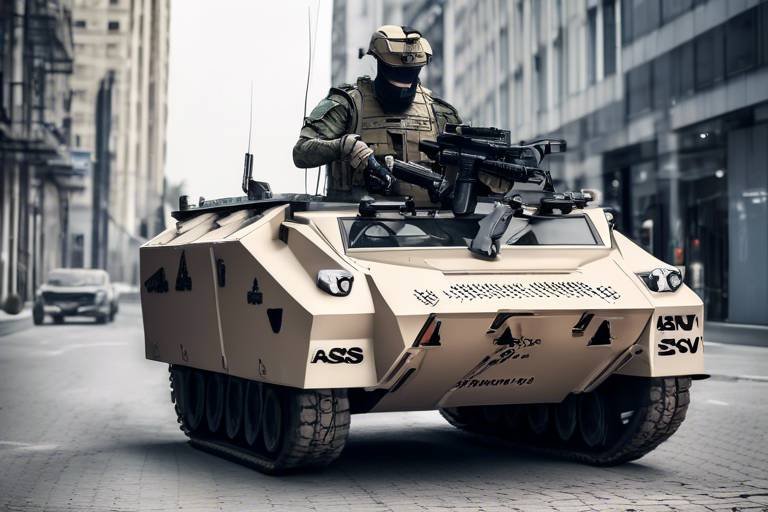Evaluating the Use of the Cheetah UAV in Tactical Reconnaissance
The Cheetah UAV has emerged as a game-changer in the realm of tactical reconnaissance, revolutionizing how military operations are conducted on the battlefield. Imagine having a bird’s-eye view of enemy movements without putting personnel at risk. That’s the magic of the Cheetah UAV! This article aims to explore the capabilities, advantages, and limitations of the Cheetah UAV, shedding light on its operational effectiveness and potential impact on modern warfare strategies. As we delve deeper, you will discover how this remarkable technology not only enhances situational awareness but also redefines the strategies employed in military operations.
The Cheetah UAV is meticulously designed for tactical reconnaissance, featuring an array of advanced technologies that significantly enhance situational awareness on the battlefield. Unlike traditional reconnaissance methods, which often involve manned aircraft and ground units, the Cheetah UAV operates remotely, providing real-time intelligence without endangering lives. Its sleek design and advanced aerodynamics allow it to cover vast areas quickly and effectively. The integration of high-tech sensors and communication systems makes the Cheetah UAV a vital asset for military operations, enabling commanders to make informed decisions based on accurate and timely data.
When it comes to technology, the Cheetah UAV is packed with cutting-edge features that set it apart from its competitors. This section delves into the various technological advancements integrated into the UAV, including sensors, communication systems, and navigation tools. Each of these components plays a crucial role in enhancing the UAV's effectiveness in reconnaissance missions. For instance, the sensors are designed to collect critical data, while the communication systems ensure that this information reaches command centers swiftly. The combination of these features not only streamlines operations but also enhances the overall success rate of reconnaissance missions.
One of the standout features of the Cheetah UAV is its impressive array of sensor capabilities. These sensors are the eyes and ears of the UAV, providing invaluable data for intelligence-gathering operations. The Cheetah UAV employs a combination of optical, infrared, and radar systems, each serving a unique purpose:
- Optical Sensors: These sensors enhance visual reconnaissance by capturing high-resolution images and videos. They are crucial for identifying enemy positions and assessing battlefield conditions, making them an essential tool for commanders.
- Infrared Sensors: Designed to detect heat signatures, these sensors allow the Cheetah UAV to conduct surveillance in low-light conditions. This capability significantly enhances its operational versatility, especially during night missions.
The communication systems of the Cheetah UAV are vital for ensuring that reconnaissance information is transmitted in real-time. These systems allow for swift and secure data transfer between the UAV and command centers, enabling military forces to act on intelligence without delay. Imagine the advantage of having immediate access to critical information during a mission—this is precisely what the Cheetah UAV offers!
The operational advantages provided by the Cheetah UAV are numerous and significant. Not only does it enhance surveillance capabilities, but it also reduces the risk to personnel and improves mission efficiency. By utilizing the Cheetah UAV for reconnaissance, military forces can minimize exposure to enemy fire, thereby safeguarding personnel during critical intelligence-gathering missions. This reduction in risk is paramount, especially in high-stakes environments where every second counts.
Utilizing the Cheetah UAV minimizes the risk to personnel during reconnaissance missions. Instead of sending soldiers into potentially hostile areas, the UAV can gather intelligence from a safe distance. This strategic advantage allows military forces to maintain operational effectiveness while prioritizing the safety of their personnel.
The UAV's advanced surveillance capabilities enable continuous monitoring of enemy activities. This constant vigilance provides commanders with timely and actionable intelligence to inform decision-making. With the Cheetah UAV, military forces can stay one step ahead of their adversaries, making it a formidable tool in modern warfare.
Despite its many advantages, the Cheetah UAV is not without its limitations and challenges. One of the most significant concerns is its vulnerability to electronic warfare. In contested environments, the UAV may face threats from electronic countermeasures that could compromise its operational effectiveness. Additionally, environmental factors such as weather conditions can impact flight stability and sensor performance, necessitating careful mission planning and risk assessment.
The susceptibility of the Cheetah UAV to electronic countermeasures poses a significant challenge. In a world where technology is constantly evolving, ensuring that the UAV can withstand these threats is critical for maintaining its operational effectiveness.
Weather conditions, such as strong winds or heavy rain, can affect the UAV's flight stability and sensor performance. This reality necessitates careful mission planning and risk assessment to ensure successful reconnaissance operations.
As we look to the future, advancements in UAV technology and tactical reconnaissance strategies are likely to enhance the capabilities of the Cheetah UAV. The potential integration of artificial intelligence into the UAV could revolutionize its operational capabilities, enabling autonomous decision-making and improved data analysis during reconnaissance missions. Future upgrades may focus on enhancing sensor technology, increasing flight endurance, and improving resistance to electronic warfare, ensuring that the Cheetah UAV remains a formidable tool for tactical reconnaissance.
The integration of artificial intelligence into the Cheetah UAV could lead to groundbreaking advancements in its operational capabilities. Imagine a UAV that can analyze data in real-time, making split-second decisions that enhance mission success. This potential for AI integration opens up exciting possibilities for the future of tactical reconnaissance.
Future upgrades may focus on enhancing sensor technology, increasing flight endurance, and improving resistance to electronic warfare. These enhancements will ensure that the Cheetah UAV remains relevant and effective in the ever-evolving landscape of military operations.
- What is the primary function of the Cheetah UAV? The Cheetah UAV is primarily designed for tactical reconnaissance, providing real-time intelligence without risking personnel.
- How does the Cheetah UAV enhance situational awareness? It utilizes advanced sensors and communication systems to gather and transmit critical data to command centers swiftly.
- What are the main challenges faced by the Cheetah UAV? Its challenges include vulnerability to electronic warfare and environmental factors that may affect its performance.

Overview of Cheetah UAV
The Cheetah UAV is a remarkable piece of technology specifically designed for tactical reconnaissance. It brings a new level of sophistication to military operations, blending advanced engineering with cutting-edge technology to enhance situational awareness on the battlefield. Imagine having a bird's eye view of the battlefield at all times; that's the power the Cheetah UAV offers. With its sleek design and robust capabilities, it stands out as a vital asset for military forces around the globe.
What sets the Cheetah UAV apart is its ability to operate in diverse environments, ranging from urban landscapes to rugged terrains. This adaptability is crucial, as military operations often require intelligence gathering in unpredictable conditions. The UAV is equipped with state-of-the-art sensors and communication systems that allow it to relay real-time data back to command centers. This information is not just a luxury; it is a necessity for making informed decisions in the heat of battle.
Furthermore, the Cheetah UAV is designed with stealth in mind. Its low radar cross-section minimizes detection, allowing it to gather intelligence without drawing attention. This stealth capability is particularly important in tactical situations where surprise can mean the difference between success and failure. In many ways, the Cheetah UAV acts like a silent guardian, watching over troops and providing critical information that can turn the tide of engagements.
To give you a clearer picture of its capabilities, here’s a quick overview:
| Feature | Description |
|---|---|
| Flight Range | Up to 150 km |
| Endurance | Approximately 12 hours |
| Payload Capacity | Up to 50 kg |
| Operating Altitude | Up to 5,000 meters |
In conclusion, the Cheetah UAV represents a significant leap forward in tactical reconnaissance technology. Its combination of advanced sensors, stealth capabilities, and operational versatility makes it an indispensable tool for modern military operations. As we delve deeper into its technological features, operational advantages, and potential limitations, it becomes clear that the Cheetah UAV is not just a tool but a game-changer in the realm of warfare.
- What is the primary purpose of the Cheetah UAV? The Cheetah UAV is primarily used for tactical reconnaissance, providing real-time intelligence to military forces.
- How does the Cheetah UAV enhance situational awareness? It uses advanced sensors and communication systems to gather and relay critical data back to command centers.
- Is the Cheetah UAV capable of operating in adverse weather conditions? While it is designed for various environments, extreme weather can impact its performance.
- What are the future prospects for the Cheetah UAV? Future developments may include the integration of AI technologies and upgrades to its sensor systems.

Technological Features
The Cheetah UAV is a marvel of modern engineering, packed with an array of cutting-edge technological features that significantly enhance its tactical reconnaissance capabilities. At the heart of its design are advanced sensors, robust communication systems, and precise navigation tools. Each of these components plays a vital role in ensuring the UAV operates effectively in diverse environments, providing military forces with the critical intelligence they need to make informed decisions on the battlefield.
One of the standout features of the Cheetah UAV is its sophisticated sensor technology. This includes a combination of optical, infrared, and radar systems, which work together to gather a comprehensive array of data that is essential for intelligence-gathering operations. The integration of these sensors allows the UAV to perform under various conditions, ensuring that it remains effective regardless of the time of day or weather conditions. For instance, during daylight, the optical sensors capture high-resolution images while infrared sensors excel in detecting heat signatures at night, making the UAV a versatile tool for continuous surveillance.
When we dive deeper into the sensor capabilities, we find that each type of sensor serves a distinct purpose:
- Optical Sensors: These sensors are designed to enhance visual reconnaissance by capturing crisp, high-resolution images and videos. This capability is crucial for identifying enemy positions and assessing battlefield conditions, allowing commanders to make quick and informed decisions.
- Infrared Sensors: These sensors are a game-changer, enabling the Cheetah UAV to detect heat signatures even in low-light environments. This feature enhances operational versatility during night missions, allowing for continuous surveillance without the limitations imposed by darkness.
- Radar Systems: The Cheetah UAV is equipped with advanced radar technology that can detect and track moving objects on the ground. This capability is particularly useful for monitoring enemy troop movements and vehicle activity, providing real-time updates to command centers.
The communication systems integrated into the Cheetah UAV are equally impressive. They are designed for real-time data transmission, ensuring that reconnaissance information reaches command centers swiftly and securely. This capability is crucial in modern warfare, where timely intelligence can mean the difference between success and failure in military operations. The UAV employs secure communication channels, minimizing the risk of interception by adversaries, thereby protecting sensitive data.
Moreover, the navigation tools embedded in the Cheetah UAV further enhance its operational effectiveness. With advanced GPS technology and inertial navigation systems, the UAV can maintain precise positioning, allowing it to execute complex flight paths and hover over critical areas for extended periods. This level of accuracy not only aids in reconnaissance but also ensures that the UAV can return safely to base, even in challenging conditions.
Q: What makes the Cheetah UAV different from other UAVs?
A: The Cheetah UAV stands out due to its advanced sensor technology, robust communication systems, and high operational versatility, allowing it to perform effective reconnaissance in various conditions.
Q: Can the Cheetah UAV operate at night?
A: Yes, the Cheetah UAV is equipped with infrared sensors that enable it to detect heat signatures, allowing for effective surveillance during nighttime operations.
Q: How does the Cheetah UAV ensure secure communication?
A: The UAV employs secure communication channels that minimize the risk of interception, ensuring that sensitive reconnaissance data is transmitted safely to command centers.

Sensor Capabilities
The Cheetah UAV is a technological marvel, particularly when it comes to its . These advanced sensors are the eyes and ears of the UAV, providing a comprehensive view of the battlefield that is crucial for effective reconnaissance. At the heart of its operational effectiveness lies a sophisticated suite of sensors that work in harmony to gather vital intelligence. Whether it’s spotting enemy movements or assessing damage in real-time, the Cheetah UAV's sensors are designed to deliver high-quality data that military commanders rely on.
One of the standout features of the Cheetah UAV is its optical sensors. These sensors capture high-resolution images and videos, allowing operators to identify enemy positions with remarkable clarity. Imagine being able to see the battlefield as if you were right there on the ground, but without the risk of exposure. This capability is not just about clarity; it’s about timeliness. The images can be transmitted back to command centers almost instantaneously, providing a real-time view of the situation. This rapid feedback loop empowers decision-makers to act swiftly, whether it’s deploying forces or adjusting strategies.
Complementing the optical sensors are the infrared sensors, which are particularly valuable during night operations or in low-visibility conditions. These sensors detect heat signatures, allowing the Cheetah UAV to spot hidden enemy units or equipment that would otherwise remain undetected. Think of it like having a pair of night vision goggles that can see through the darkness, giving military personnel a significant advantage when others are blind. This capability not only enhances the UAV’s operational versatility but also ensures that missions can be conducted around the clock, regardless of the time of day.
Moreover, the Cheetah UAV is equipped with radar systems that further enhance its reconnaissance capabilities. These radar systems can detect moving targets over vast distances, providing a comprehensive overview of enemy movements and activities. By integrating multiple sensor types, the Cheetah UAV creates a layered approach to intelligence gathering. This multifaceted sensor architecture allows for cross-verification of data, ensuring that the information received is accurate and reliable.
In summary, the sensor capabilities of the Cheetah UAV are a cornerstone of its effectiveness in tactical reconnaissance. By leveraging advanced optical, infrared, and radar technologies, the UAV can provide a level of situational awareness that is critical for modern military operations. As technology continues to advance, we can only imagine how these sensor capabilities will evolve, further enhancing the Cheetah UAV's role in the battlefield of the future.
- What types of sensors does the Cheetah UAV use?
The Cheetah UAV employs optical, infrared, and radar sensors to gather intelligence. - How does the infrared sensor work?
Infrared sensors detect heat signatures, making them effective in low-light conditions. - Can the Cheetah UAV operate at night?
Yes, the integration of infrared sensors allows the UAV to conduct operations during nighttime. - How quickly can data be transmitted from the Cheetah UAV?
Data can be transmitted in real-time, providing immediate situational awareness to command centers.

Optical Sensors
The integrated into the Cheetah UAV represent a significant leap forward in tactical reconnaissance technology. These sensors are not just your run-of-the-mill cameras; they are sophisticated devices capable of capturing high-resolution images and videos that are crucial for military operations. Imagine being able to spot an enemy position from miles away, with clarity so sharp that every detail is visible. That's the power of optical sensors!
Equipped with advanced imaging capabilities, the Cheetah UAV's optical sensors can operate in various light conditions, allowing for effective reconnaissance during both day and twilight hours. This versatility is essential for modern warfare, where the battlefield can change dramatically from day to night. The ability to gather visual intelligence in real-time means commanders can make informed decisions swiftly, which is vital in high-stakes situations.
Furthermore, the data collected by these sensors can be analyzed on the fly. Imagine the advantage of having a team of analysts reviewing images and videos while the UAV is still in the air, providing immediate feedback to ground troops. This operational synergy enhances situational awareness and allows for rapid response to emerging threats. The optical sensors can also be paired with other sensor types, such as infrared, to create a comprehensive picture of the battlefield.
However, it's important to note that while optical sensors offer remarkable capabilities, they are not without their challenges. For instance, they can be affected by environmental factors such as fog, rain, or smoke, which may obscure visibility. Thus, careful mission planning is essential to mitigate these risks. The integration of optical sensors into the Cheetah UAV is a game-changer, making it a critical asset in the realm of tactical reconnaissance.
- What are optical sensors? Optical sensors are devices that capture visual data, such as images and videos, enabling reconnaissance and surveillance operations.
- How do optical sensors enhance reconnaissance? They provide high-resolution imagery that helps identify enemy positions and assess battlefield conditions, improving situational awareness for commanders.
- Can optical sensors operate in low-light conditions? Yes, while primarily effective in daylight, they can also function during twilight hours, although their performance may vary depending on the specific technology used.
- What environmental factors can affect optical sensors? Weather conditions such as fog, rain, or smoke can obscure visibility and impact the effectiveness of optical sensors.

Infrared Sensors
Infrared sensors are a game-changer for the Cheetah UAV, significantly enhancing its operational versatility, especially during low-light conditions. Imagine being able to see through the darkness, detecting threats that would otherwise remain hidden. This capability is crucial on the battlefield, where the element of surprise can mean the difference between success and failure. By utilizing infrared technology, the Cheetah UAV can detect heat signatures from enemy personnel and equipment, providing valuable intelligence that traditional optical sensors might miss.
These sensors work by capturing infrared radiation, which is emitted by all objects based on their temperature. This means that regardless of visibility—be it pitch-black nights or obscured environments—the Cheetah UAV can still perform its reconnaissance missions effectively. For instance, during night operations, the UAV can identify enemy positions, track movements, and assess potential threats without exposing ground troops to danger.
Furthermore, the integration of infrared sensors allows for a range of operational advantages:
- Enhanced Target Acquisition: Infrared sensors can pinpoint the location of enemy forces, even through foliage or other obstacles.
- Improved Situational Awareness: Commanders receive real-time data, enabling quicker decision-making based on accurate threat assessments.
- Versatility in Various Environments: Whether it's a desert, forest, or urban setting, infrared technology adapts to different terrains and conditions.
However, it's essential to note that while infrared sensors provide significant benefits, they are not without limitations. For example, heavy rain or fog can scatter infrared signals, potentially reducing effectiveness. Therefore, mission planning is critical to ensure that the UAV operates under optimal conditions.
In summary, the Cheetah UAV's infrared sensors play a pivotal role in tactical reconnaissance. They not only enhance the UAV's ability to gather intelligence during challenging conditions but also contribute to the overall safety of military personnel by minimizing their exposure to threats. As technology continues to advance, we can expect these sensors to become even more sophisticated, further solidifying their importance in modern warfare.
- What are infrared sensors used for in UAVs? Infrared sensors are primarily used for detecting heat signatures, which helps in identifying enemy positions and monitoring activities, especially in low-light conditions.
- How do infrared sensors work? They capture infrared radiation emitted by objects based on their temperature, allowing the UAV to "see" in the dark or through obstacles.
- What are the limitations of infrared sensors? Environmental factors such as rain, fog, or smoke can affect their performance, requiring careful mission planning.
- Can infrared sensors be used during the day? Yes, infrared sensors can be effective during the day, but they are particularly advantageous in low-light or nighttime operations.

Communication Systems
The communication systems integrated into the Cheetah UAV are nothing short of revolutionary. They serve as the backbone of its operational effectiveness, ensuring that vital reconnaissance data is transmitted in real-time to command centers. Imagine a battlefield where every second counts; the Cheetah UAV's communication capabilities allow for swift and secure data transfer, making it an invaluable asset in tactical situations. Equipped with state-of-the-art communication technologies, this UAV maintains a robust link with ground forces, allowing for seamless coordination and immediate response to emerging threats.
One of the standout features of the Cheetah UAV's communication systems is its ability to utilize multiple frequencies. This multi-band capability not only enhances the reliability of transmissions but also minimizes the risk of interception by enemy forces. Additionally, the UAV can switch frequencies dynamically, ensuring that the communication link remains stable even in contested environments. This adaptability is crucial, as it allows operators to maintain situational awareness without compromising security.
Moreover, the Cheetah UAV employs advanced encryption protocols to safeguard the information being transmitted. In a world where cyber threats are increasingly prevalent, protecting sensitive data is paramount. The UAV's communication systems ensure that intelligence gathered during reconnaissance missions remains confidential and secure from prying eyes. This level of security empowers military leaders to make informed decisions based on accurate and timely information.
To illustrate the effectiveness of the Cheetah UAV's communication systems, consider the following table that outlines its key features:
| Feature | Description |
|---|---|
| Multi-band Frequency | Utilizes various frequencies for enhanced reliability and reduced interception risk. |
| Dynamic Frequency Switching | Automatically switches frequencies to maintain a stable communication link. |
| Advanced Encryption | Employs robust encryption protocols to protect sensitive data during transmission. |
In addition to these features, the Cheetah UAV is equipped with a user-friendly interface that allows operators to monitor communication channels effectively. This interface provides real-time feedback on signal strength and data integrity, ensuring that any potential issues can be addressed promptly. The result is a highly efficient communication system that not only enhances the UAV's reconnaissance capabilities but also contributes to the overall success of military operations.
In conclusion, the communication systems of the Cheetah UAV are a testament to modern military technology. They not only facilitate real-time data transmission but also ensure that the information is secure and reliable. As military strategies continue to evolve, the importance of effective communication in tactical reconnaissance cannot be overstated. The Cheetah UAV stands at the forefront of this evolution, ready to meet the challenges of modern warfare head-on.
- What is the primary function of the Cheetah UAV?
The Cheetah UAV is primarily used for tactical reconnaissance, providing real-time intelligence to military commanders. - How does the Cheetah UAV ensure data security?
It employs advanced encryption protocols and multi-band frequency communication to protect sensitive information during transmission. - Can the Cheetah UAV operate in adverse weather conditions?
While it is designed for versatility, extreme weather conditions can still affect its performance, necessitating careful mission planning. - What future developments are expected for the Cheetah UAV?
Future advancements may include integration of AI technologies and upgrades to enhance sensor capabilities and resistance to electronic warfare.

Operational Advantages
The Cheetah UAV is rapidly becoming a game-changer in the realm of tactical reconnaissance. Its design and functionality bring a slew of that not only enhance military strategies but also redefine how reconnaissance missions are conducted. One of the most significant benefits is the reduced risk to personnel. In traditional reconnaissance, soldiers often had to venture into hostile territories, exposing themselves to enemy fire. However, with the Cheetah UAV, military forces can gather crucial intelligence from a safe distance, minimizing the risk of casualties. Imagine being able to monitor enemy movements without ever setting foot on the battlefield—this is the reality the Cheetah UAV offers.
Furthermore, the UAV's enhanced surveillance capabilities enable continuous monitoring of enemy activities. Equipped with state-of-the-art sensors, the Cheetah can provide real-time data that is vital for tactical decision-making. Commanders can receive timely and actionable intelligence, which can be the difference between mission success and failure. For instance, during a reconnaissance mission, the UAV can identify troop concentrations or supply routes, allowing ground forces to strategize their next move effectively.
Additionally, the Cheetah UAV's ability to operate in various environments adds to its operational versatility. Whether it's the scorching heat of a desert or the dense foliage of a jungle, the UAV is designed to adapt and perform optimally. This adaptability is crucial for military operations that often take place in unpredictable conditions. Moreover, the UAV's capability to fly at different altitudes allows it to conduct surveillance from a safe distance while still gathering high-quality data.
To further illustrate the operational advantages of the Cheetah UAV, consider the following table that summarizes its key benefits:
| Advantage | Description |
|---|---|
| Reduced Risk to Personnel | Minimizes exposure to enemy fire by conducting reconnaissance from a safe distance. |
| Enhanced Surveillance | Provides real-time data for tactical decision-making, improving mission outcomes. |
| Operational Versatility | Adapts to various environments and conditions, ensuring effective performance. |
| Continuous Monitoring | Allows for ongoing surveillance, keeping commanders informed of enemy movements. |
In summary, the operational advantages of the Cheetah UAV are profound. By reducing risks to personnel, enhancing surveillance capabilities, and demonstrating operational versatility, this UAV is not just a tool but a vital asset in modern warfare. As military strategies continue to evolve, the Cheetah UAV stands at the forefront, providing the necessary support to ensure mission success.
- What is the primary function of the Cheetah UAV? The Cheetah UAV is primarily designed for tactical reconnaissance, providing real-time intelligence and surveillance capabilities.
- How does the Cheetah UAV reduce risks to personnel? By conducting reconnaissance missions from a safe distance, the Cheetah UAV minimizes the need for soldiers to enter hostile environments.
- Can the Cheetah UAV operate in adverse weather conditions? Yes, the Cheetah UAV is designed to perform in various environmental conditions, enhancing its operational versatility.
- What types of sensors does the Cheetah UAV use? The Cheetah UAV employs a range of sensors, including optical, infrared, and radar systems, to gather critical intelligence.

Reduced Risk to Personnel
The introduction of the Cheetah UAV into tactical reconnaissance missions represents a significant shift in how military operations are conducted, particularly when it comes to safeguarding personnel. Traditionally, reconnaissance missions have placed soldiers in harm's way, often requiring them to venture into hostile territories to gather vital intelligence. However, with the Cheetah UAV taking to the skies, the risk of exposure to enemy fire is drastically minimized. This drone acts as the eyes in the sky, allowing military forces to monitor enemy movements and gather crucial data without putting troops directly in danger.
One of the most compelling aspects of using the Cheetah UAV is its ability to operate in environments that would otherwise be too dangerous for human reconnaissance teams. Imagine a situation where ground troops are tasked with gathering intelligence in a densely populated area known for enemy activity. Instead of sending in a squad, which could easily become a target, commanders can deploy the Cheetah UAV to perform the mission from a safe distance. This not only protects personnel but also enhances the overall effectiveness of the operation.
Moreover, the Cheetah UAV can fly high above the battlefield, providing a bird's-eye view that traditional reconnaissance methods simply cannot match. Its advanced sensors and cameras are designed to capture high-resolution images and videos, allowing for detailed analysis of enemy positions without the risk of direct confrontation. This capability is particularly beneficial in scenarios where the element of surprise is crucial; the UAV can gather intelligence without alerting the enemy to its presence.
In addition to its tactical advantages, the Cheetah UAV also contributes to improved mission efficiency. By reducing the need for personnel to engage in dangerous reconnaissance missions, military planners can allocate resources more effectively. Troops can focus on other critical tasks, such as planning offensive operations or securing strategic locations, while the UAV handles the intelligence-gathering aspect. This streamlined approach not only saves lives but also enhances the overall effectiveness of military operations.
However, it is essential to recognize that while the Cheetah UAV significantly reduces risks to personnel, it does not eliminate them entirely. There are still challenges to consider, such as the potential for electronic warfare tactics that could disrupt UAV operations. Military strategists must remain vigilant and prepare for contingencies to ensure that the UAV can operate effectively in contested environments. Nonetheless, the overall reduction in risk to personnel provided by the Cheetah UAV marks a notable advancement in modern warfare, allowing for more strategic and safer reconnaissance missions.
- How does the Cheetah UAV enhance reconnaissance missions?
The Cheetah UAV provides real-time intelligence without risking personnel, using advanced sensors to monitor enemy activities from a safe distance. - What types of environments can the Cheetah UAV operate in?
The Cheetah UAV is designed to function effectively in various environments, including urban areas and hostile territories, while minimizing exposure to danger. - Are there any risks associated with using the Cheetah UAV?
While the Cheetah UAV reduces risks to personnel, it is still vulnerable to electronic warfare and environmental factors that could impact its performance. - What future advancements can we expect for the Cheetah UAV?
Future developments may include enhanced sensor technology, increased flight endurance, and improved resistance to electronic countermeasures.

Enhanced Surveillance
The Cheetah UAV is a game-changer when it comes to enhanced surveillance capabilities on the battlefield. Imagine having a bird's-eye view of the entire area, equipped with cutting-edge technology that allows military forces to monitor enemy movements in real-time. This level of situational awareness is not just an advantage; it's a necessity in modern warfare. The UAV's ability to provide continuous and detailed surveillance ensures that commanders are always one step ahead, making informed decisions based on timely intelligence.
One of the standout features of the Cheetah UAV is its capacity for persistent surveillance. This means that it can loiter over an area for extended periods, gathering crucial data without the need for constant redeployment. This capability is particularly beneficial for monitoring high-value targets or sensitive locations. The UAV can collect and relay information such as troop movements, supply routes, and even changes in the battlefield environment, which are vital for strategic planning.
Moreover, the Cheetah UAV is equipped with advanced sensor suites that enhance its surveillance capabilities. These sensors can capture high-resolution images and videos, allowing for precise identification of enemy positions. The integration of optical and infrared sensors means that the UAV can operate effectively in various conditions, whether it's bright daylight or the cover of night. For instance, during nighttime operations, the infrared sensors can detect heat signatures, revealing hidden enemy assets that would otherwise remain undetected.
In addition to its impressive sensor technology, the Cheetah UAV's real-time data transmission capabilities ensure that information is swiftly relayed to command centers. This immediacy allows military leaders to make quick decisions based on the latest intelligence. Imagine a scenario where troops are moving through a hostile area; having up-to-date information about enemy positions can mean the difference between success and failure. The UAV acts as an eye in the sky, providing a continuous stream of actionable intelligence that can significantly enhance mission outcomes.
Furthermore, the Cheetah UAV's enhanced surveillance capabilities help in minimizing risks to personnel. By utilizing the UAV for reconnaissance, military forces can gather intelligence without putting soldiers in harm's way. This not only protects lives but also allows for more strategic planning and execution of operations. In essence, the UAV serves as a force multiplier, amplifying the effectiveness of ground troops while keeping them safe from enemy fire.
In conclusion, the Cheetah UAV's enhanced surveillance capabilities represent a significant advancement in tactical reconnaissance. Its combination of persistent monitoring, advanced sensor technology, and real-time data transmission creates a powerful tool for military operations. As warfare continues to evolve, the Cheetah UAV stands out as a critical asset that provides the intelligence needed to navigate complex battlefields successfully.
- What is the primary function of the Cheetah UAV?
The primary function of the Cheetah UAV is to conduct tactical reconnaissance, providing real-time intelligence and enhancing situational awareness on the battlefield. - How does the Cheetah UAV improve personnel safety?
By utilizing the UAV for reconnaissance missions, military forces can gather intelligence without exposing soldiers to enemy fire, thereby minimizing risk to personnel. - What types of sensors are integrated into the Cheetah UAV?
The Cheetah UAV is equipped with optical, infrared, and radar sensors, which allow for comprehensive surveillance under various conditions. - Can the Cheetah UAV operate at night?
Yes, the Cheetah UAV can operate at night using its infrared sensors, which detect heat signatures and provide visibility in low-light conditions. - What advancements are expected for the Cheetah UAV in the future?
Future developments may include the integration of artificial intelligence, enhancements in sensor technology, and improved resistance to electronic warfare.

Limitations and Challenges
While the Cheetah UAV boasts impressive capabilities, it is not without its limitations and challenges. Understanding these hurdles is crucial for military strategists and operators who rely on this technology for tactical reconnaissance. One of the most significant concerns is its vulnerability to electronic warfare. In modern combat scenarios, adversaries are increasingly employing sophisticated electronic countermeasures designed to disrupt UAV operations. This susceptibility can severely compromise the Cheetah's ability to gather intelligence effectively, making it a target for enemy forces who can exploit these weaknesses.
Moreover, environmental factors pose another significant challenge. Weather conditions, such as strong winds, heavy rain, or extreme temperatures, can impact the UAV's flight stability and sensor performance. For instance, during a reconnaissance mission, if the Cheetah encounters unexpected weather changes, its ability to maintain a stable flight path may be jeopardized, leading to potential data loss or mission failure. Therefore, meticulous mission planning and risk assessment become paramount to mitigate these environmental impacts.
Additionally, the operational range of the Cheetah UAV can be limited by its battery life and fuel capacity. While advancements in battery technology are ongoing, the current limitations mean that missions must be carefully timed to ensure the UAV returns safely without running out of power. This constraint necessitates a strategic approach to reconnaissance, balancing the need for extensive surveillance with the realities of operational endurance.
In summary, while the Cheetah UAV is an invaluable asset in tactical reconnaissance, its effectiveness can be hindered by electronic warfare vulnerabilities, environmental conditions, and operational range limitations. Addressing these challenges is essential for maximizing its potential and ensuring successful mission outcomes.
- What are the main limitations of the Cheetah UAV? The Cheetah UAV faces challenges such as vulnerability to electronic warfare, environmental factors affecting performance, and limitations in operational range due to battery life.
- How does electronic warfare impact UAV operations? Electronic warfare can disrupt the communication and navigation systems of UAVs, compromising their ability to gather and transmit intelligence.
- What environmental conditions can affect the Cheetah UAV? Weather conditions like strong winds, heavy rain, and extreme temperatures can impact flight stability and sensor performance.
- What advancements are being made to overcome these limitations? Future developments may include enhanced sensor technology, improved battery life, and better resistance to electronic countermeasures.

Vulnerability to Electronic Warfare
The Cheetah UAV, while a remarkable tool for tactical reconnaissance, is not without its vulnerabilities, particularly in the realm of electronic warfare. In modern conflict, where technology plays a pivotal role, the ability to disrupt or interfere with enemy systems has become a critical strategy. This means that the Cheetah UAV can be susceptible to a range of electronic countermeasures designed to jam its communication systems or spoof its navigation capabilities.
One of the primary concerns is the UAV's reliance on radio frequency (RF) communications. These frequencies can be intercepted or jammed by adversaries equipped with sophisticated electronic warfare capabilities. When this happens, the UAV may lose its ability to transmit vital reconnaissance data back to command centers, rendering it less effective in its mission. Imagine sending a scout into enemy territory only for them to lose contact at the most critical moment—this is the reality that operators face with the Cheetah UAV.
Moreover, the UAV's navigation systems can also be compromised. Many UAVs, including the Cheetah, depend on GPS for accurate positioning. If an enemy employs GPS jamming techniques, the UAV may struggle to maintain its flight path, leading to potential mission failure or, worse, capture by hostile forces. The implications of such vulnerabilities are significant, as they can result in the loss of not just the UAV itself, but also the invaluable intelligence it was gathering.
To illustrate the various aspects of vulnerability to electronic warfare, consider the following table:
| Type of Vulnerability | Description | Potential Impact |
|---|---|---|
| Communication Jamming | Interruption of RF signals used for data transmission | Loss of real-time intelligence |
| GPS Spoofing | Manipulation of GPS signals to mislead navigation | Loss of control and potential crash |
| Sensor Interference | Disruption of onboard sensors | Inaccurate data collection |
In light of these challenges, military strategists must prioritize the development of countermeasures to protect the Cheetah UAV from electronic warfare threats. This could involve enhancing the UAV's resilience through advanced encryption techniques for communications, implementing alternative navigation systems that are less susceptible to jamming, or even developing stealth technology to minimize detection. The battlefield of tomorrow will undoubtedly be shaped by how well these vulnerabilities are addressed today.
As we look to the future, the integration of more robust electronic warfare countermeasures will be essential for the continued operational success of the Cheetah UAV. The evolution of warfare demands that we stay one step ahead, ensuring that our tactical reconnaissance capabilities remain effective, even in the face of sophisticated enemy tactics.
- What is electronic warfare? Electronic warfare refers to military actions that use electromagnetic energy to control the electromagnetic spectrum or to attack an enemy.
- How does electronic warfare affect UAV operations? It can disrupt communication and navigation systems, potentially compromising the UAV's mission and safety.
- What measures can be taken to protect UAVs from electronic warfare? Enhancing encryption, using alternative navigation systems, and developing stealth technologies are some ways to mitigate these risks.

Environmental Factors
The operational effectiveness of the Cheetah UAV is significantly influenced by various . Just like a seasoned sailor who knows when to set sail and when to wait for calmer waters, UAV operators must be acutely aware of the conditions that can impact flight stability and sensor performance. Weather plays a pivotal role in determining whether a mission can proceed as planned or if adjustments are necessary.
For instance, strong winds can pose a serious threat to the stability of the Cheetah UAV. High gusts can lead to uncontrolled maneuvers, making it difficult for the UAV to maintain its intended flight path. This instability can result in inaccurate data collection, which is counterproductive during reconnaissance missions. Similarly, heavy rain can obstruct optical sensors, reducing visibility and hindering the UAV's ability to capture clear images and videos. Imagine trying to take a photograph during a downpour; the results would be far from ideal.
Moreover, temperature fluctuations can also affect the UAV's performance. Extreme heat can lead to overheating of the electronics, while cold temperatures can impact battery life, ultimately reducing flight endurance. Thus, mission planners must consider the weather forecast and the specific environmental conditions of the operational area. A thorough risk assessment is essential to ensure that the Cheetah UAV can perform optimally under varying circumstances.
To illustrate the impact of environmental factors on UAV operations, the following table summarizes key weather conditions and their potential effects:
| Weather Condition | Potential Effects |
|---|---|
| Strong Winds | Instability, difficulty maintaining flight path |
| Heavy Rain | Obscured visibility, reduced image quality |
| Extreme Heat | Overheating of electronics, reduced performance |
| Cold Temperatures | Decreased battery life, limited flight endurance |
In summary, environmental factors are not merely background noise; they are critical elements that can dictate the success or failure of a reconnaissance mission. Just as a chess player anticipates their opponent's moves, UAV operators must anticipate how weather conditions could affect their operations. By understanding and preparing for these environmental challenges, military forces can enhance the effectiveness of the Cheetah UAV and ensure that it remains a reliable asset in tactical reconnaissance.
- What types of weather can impact UAV operations? Strong winds, heavy rain, extreme heat, and cold temperatures can all negatively affect UAV performance.
- How does the Cheetah UAV adapt to changing weather conditions? Operators must conduct thorough mission planning and risk assessments to determine the feasibility of operations under specific weather conditions.
- What measures can be taken to mitigate environmental risks? Utilizing advanced weather tracking technology and maintaining flexibility in mission planning can help mitigate risks associated with environmental factors.

Future Developments
The future of the Cheetah UAV is brimming with potential, as advancements in technology and tactical strategies promise to enhance its capabilities significantly. As military operations evolve, so too must the tools used in reconnaissance. One of the most exciting prospects is the integration of artificial intelligence (AI). Imagine a UAV that can not only gather data but also analyze it in real-time, making autonomous decisions based on the information it collects. This leap into AI technology could transform the Cheetah UAV into an even more formidable asset on the battlefield.
Moreover, upgrades focusing on sensor technology are on the horizon. As the demand for more precise and varied data increases, enhancing the UAV's sensors to include advanced imaging and detection capabilities will be crucial. This could involve the implementation of multi-spectral sensors that provide a richer understanding of the environment, allowing for better identification of threats and opportunities.
Additionally, increasing the flight endurance of the Cheetah UAV will be a priority. The ability to stay airborne for extended periods without needing to return for fuel or maintenance can drastically improve surveillance missions. Imagine a scenario where a UAV can monitor a specific area for hours, providing continuous intelligence without interruption. This would not only enhance operational efficiency but also ensure that commanders have access to the most current information.
Another significant area of development lies in improving the UAV's resistance to electronic warfare. As adversaries become more adept at using electronic countermeasures, the Cheetah UAV must evolve to counter these threats. Future upgrades may include advanced encryption methods and more resilient communication systems that can withstand attempts to jam or disrupt its signals.
In summary, the Cheetah UAV is on the cusp of a transformation that could redefine its role in tactical reconnaissance. With the integration of AI, enhanced sensors, improved endurance, and resistance to electronic warfare, the Cheetah UAV will not only maintain its relevance but will also become an indispensable tool in modern military operations.
- What is the primary function of the Cheetah UAV?
The Cheetah UAV is primarily designed for tactical reconnaissance, providing critical intelligence on enemy positions and battlefield conditions. - How does AI integration improve the Cheetah UAV?
AI integration allows for autonomous decision-making and enhanced data analysis, enabling the UAV to operate more effectively in complex environments. - What are the limitations of the Cheetah UAV?
Some limitations include vulnerability to electronic warfare and potential performance issues in adverse weather conditions. - What advancements can we expect in the future?
Future advancements may include improved sensor technology, increased flight endurance, and enhanced resistance to electronic countermeasures.

Integration of AI Technologies
This article explores the capabilities, advantages, and limitations of the Cheetah UAV in tactical reconnaissance missions, highlighting its operational effectiveness and potential impact on modern warfare strategies.
The Cheetah UAV is designed for tactical reconnaissance, featuring advanced technology and capabilities that enhance situational awareness on the battlefield, making it a vital asset for military operations.
This section delves into the cutting-edge technology integrated into the Cheetah UAV, including sensors, communication systems, and navigation tools that contribute to its effectiveness in reconnaissance missions.
An examination of the various sensors employed by the Cheetah UAV, including optical, infrared, and radar systems, which provide critical data for intelligence-gathering operations.
Optical sensors enhance visual reconnaissance by capturing high-resolution images and videos, crucial for identifying enemy positions and assessing battlefield conditions.
Infrared sensors enable the Cheetah UAV to detect heat signatures, facilitating surveillance in low-light conditions and enhancing its operational versatility during night missions.
The communication systems of the Cheetah UAV are vital for real-time data transmission, ensuring that reconnaissance information reaches command centers swiftly and securely.
This section highlights the strategic advantages offered by the Cheetah UAV, including enhanced surveillance capabilities, reduced risk to personnel, and improved mission efficiency.
By utilizing the Cheetah UAV for reconnaissance, military forces can minimize exposure to enemy fire, thereby safeguarding personnel during critical intelligence-gathering missions.
The UAV's advanced surveillance capabilities enable continuous monitoring of enemy activities, providing commanders with timely and actionable intelligence to inform decision-making.
Despite its advantages, the Cheetah UAV faces certain limitations and challenges, including vulnerability to electronic warfare and environmental factors that may affect its performance.
The susceptibility of the Cheetah UAV to electronic countermeasures poses a significant challenge, potentially compromising its operational effectiveness in contested environments.
Weather conditions, such as strong winds or heavy rain, can impact the UAV's flight stability and sensor performance, necessitating careful mission planning and risk assessment.
Looking ahead, advancements in UAV technology and tactical reconnaissance strategies may enhance the capabilities of the Cheetah UAV, ensuring its relevance in future military operations.
The potential integration of artificial intelligence into the Cheetah UAV could revolutionize its operational capabilities, enabling autonomous decision-making and improved data analysis during reconnaissance missions. Imagine a scenario where the UAV can analyze vast amounts of data in real-time, identifying patterns and anomalies that a human operator might miss. This capability would not only speed up the reconnaissance process but also enhance the accuracy of the intelligence gathered.
AI technologies can assist the Cheetah UAV in several ways:
- Autonomous Navigation: AI can enable the UAV to navigate complex environments without human intervention, allowing for more efficient mission execution.
- Predictive Analytics: By analyzing historical data, AI can predict enemy movements and behaviors, providing commanders with actionable insights.
- Enhanced Target Recognition: Machine learning algorithms can improve the UAV's ability to distinguish between friend and foe, reducing the risk of friendly fire incidents.
Furthermore, the integration of AI could lead to significant cost savings in the long run. With the ability to automate routine tasks and analyze data faster, military forces could allocate their resources more effectively, focusing on strategic decision-making rather than data processing. As technology continues to evolve, the Cheetah UAV stands to benefit immensely from these advancements, solidifying its role as a critical asset in modern warfare.
The Cheetah UAV is an unmanned aerial vehicle designed for tactical reconnaissance, equipped with advanced sensors and communication systems to enhance battlefield situational awareness.
AI enhances the Cheetah UAV's capabilities by enabling autonomous navigation, predictive analytics, and improved target recognition, which leads to faster and more accurate intelligence gathering.
Some limitations include vulnerability to electronic warfare and environmental factors such as adverse weather conditions that can affect its performance.
Tactical reconnaissance is crucial as it provides military forces with timely and actionable intelligence, allowing for informed decision-making and strategic planning in combat situations.

Potential Upgrades
The future of the Cheetah UAV looks promising, especially when we consider the potential upgrades that could significantly enhance its operational capabilities. As military tactics evolve and the battlefield becomes more complex, the need for advanced technology in reconnaissance missions is paramount. One of the most exciting avenues for improvement lies in the integration of next-generation sensor technologies. These upgrades could enable the Cheetah UAV to gather even more precise intelligence, with enhanced resolution and broader spectral coverage. Imagine a UAV that could not only see the battlefield in high definition but also detect chemical signatures or even track movements through foliage with ease!
Another critical area for potential upgrades is the UAV's flight endurance. Currently, the Cheetah UAV has a respectable flight time, but as missions become longer and more demanding, extending this capability could be a game-changer. Innovations in battery technology or the incorporation of hybrid power systems could allow the Cheetah to stay airborne longer, providing continuous surveillance without the need for frequent landings. This would be particularly beneficial in time-sensitive operations where every second counts.
Moreover, enhancing the Cheetah UAV's resistance to electronic warfare is essential. As adversaries become more adept at deploying countermeasures, the Cheetah must evolve to maintain its effectiveness. Future upgrades could include advanced encryption for data transmission and more robust electronic counter-countermeasures (ECCM) to ensure that the UAV remains operational even in contested environments. This would not only protect the UAV but also secure the valuable intelligence it gathers.
Lastly, the integration of artificial intelligence (AI) into the Cheetah UAV could revolutionize its operational capabilities. AI could facilitate autonomous decision-making, allowing the UAV to adapt to changing battlefield conditions in real-time. For instance, if the UAV detects an unexpected enemy presence, it could automatically adjust its flight path or change its sensor focus to gather critical data without waiting for human intervention. This level of responsiveness could provide military commanders with an unprecedented advantage.
In summary, the potential upgrades for the Cheetah UAV are vast and varied. By focusing on advanced sensor technologies, enhancing flight endurance, improving resistance to electronic warfare, and integrating AI, the Cheetah can remain a formidable tool in tactical reconnaissance. Each of these upgrades not only promises to improve the UAV's performance but also ensures that it stays relevant in the rapidly evolving landscape of modern warfare.
- What are the main advantages of the Cheetah UAV?
The Cheetah UAV offers enhanced surveillance capabilities, reduced risk to personnel, and improved mission efficiency, making it a vital asset in tactical reconnaissance. - How does the Cheetah UAV perform in adverse weather conditions?
While the Cheetah UAV is designed for various environments, extreme weather conditions can impact its flight stability and sensor performance, requiring careful mission planning. - What future technologies could enhance the Cheetah UAV?
Future upgrades may include advanced sensors, longer flight endurance, improved resistance to electronic warfare, and the integration of AI for autonomous operations. - How does the Cheetah UAV gather intelligence?
The Cheetah UAV utilizes a combination of optical, infrared, and radar sensors to collect critical data for intelligence-gathering operations.
Frequently Asked Questions
- What is the primary purpose of the Cheetah UAV?
The Cheetah UAV is primarily designed for tactical reconnaissance, providing military forces with enhanced situational awareness on the battlefield. It helps gather crucial intelligence, monitor enemy movements, and assess battlefield conditions effectively.
- What kind of sensors does the Cheetah UAV utilize?
The Cheetah UAV is equipped with advanced sensors, including optical, infrared, and radar systems. These sensors work together to capture high-resolution images and detect heat signatures, allowing for comprehensive surveillance in various conditions.
- How does the Cheetah UAV enhance mission efficiency?
By utilizing the Cheetah UAV, military operations can significantly reduce the risk to personnel while ensuring continuous monitoring of enemy activities. This leads to timely and actionable intelligence, which is crucial for effective decision-making during missions.
- What are the limitations of the Cheetah UAV?
Despite its advantages, the Cheetah UAV faces challenges such as vulnerability to electronic warfare, which can compromise its effectiveness in contested environments. Additionally, environmental factors like strong winds and heavy rain can impact its flight stability and sensor performance.
- Are there any future developments planned for the Cheetah UAV?
Yes, future developments may include the integration of artificial intelligence to enhance autonomous decision-making and improve data analysis. Upgrades may also focus on enhancing sensor technology, increasing flight endurance, and improving resistance to electronic warfare.
- Can the Cheetah UAV operate at night?
Absolutely! The Cheetah UAV is equipped with infrared sensors that enable it to detect heat signatures, making it highly effective for surveillance during low-light conditions and night missions.
- How quickly can the Cheetah UAV transmit data?
The communication systems integrated into the Cheetah UAV ensure real-time data transmission, which allows reconnaissance information to reach command centers swiftly and securely. This rapid communication is vital for timely operational responses.



